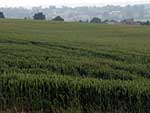 |
|
||||
|
|
Fieldwork: Fieldwalking
A full map-based analysis of the fieldwalking results may be seen HERE (on the CLASP website). In addition to the metal detecting survey the area was intensively fieldwalked over two seasons (1997 / 1998 ) by Mr. Stephen Young, Senior Lecturer in Archaeology at University College, Northampton. A great deal of material dating from the 1st to 4th centuries was discovered and recorded. Analysis of the data revealed coherent scatters of pottery and building material covering an area in excess of two hectares and spread across two fields.The range of finds was indicative of a long lived and intense occupation of the area. It was also possible to explore settlement shift across the site and gain some understanding of the range of sophisticated buildings erected during the Roman period. Large quantities of ceramic roof and floor tile representing several different fabrics underlined the existence of architecturally complex structures. Substantial numbers of tesserae were also located although the overall number suggested either that the floors were still intact or had been methodically removed at some unspecifiable post Roman date. Considerable amounts of boxflue associated with underfloor heating and bathing facilities were evident in discreet surface distributions. Pottery sherds representing over 35 different pottery fabrics of local regional and international manufacture were retrieved. |
||||
|